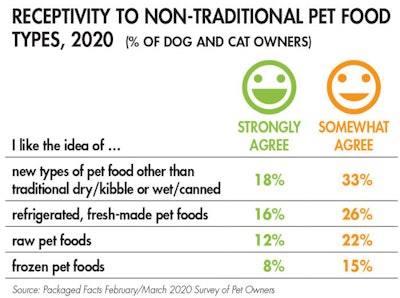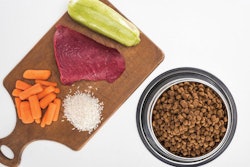
As reported in Packaged Facts’ Pet Food in the U.S. (June 2020), pet owners are increasingly turning to fresh pet food concepts. “Fresh” has long been the top selling point for human foods, even above heavyweight contenders such as price, flavor and convenience. In this pets-as-family era, therefore, the writing is on the wall in terms of the potential of fresh among human-to-pet food crossover trends in superpremium pet foods. However, the especially challenging logistics of pet food, which are reflected in product pricing, remain a significant counterweight.
Market receptivity to and use of “fresh”
Packaged Facts survey data show that pet owners are fairly open to new types of foods, with over half (51%) somewhat or strongly agreeing that they like the idea of new types of pet food other than traditional dry/kibble or wet/canned, and 42% somewhat or strongly agreeing that they like the idea of refrigerated, fresh-made foods specifically (see Table 1). Interest in raw (34%) and frozen (23%) pet foods is also significant, though not quite as high. With the caveat that “somewhat agree” outweighs “strongly agree” with receptivity for each of these alternative pet food types, the numbers confirm market potential for fresher, non-traditional foods.

The majority of pet owners surveyed at least somewhat agree that they’re open to new types of pet food, and fresh-made was at the top of the list of alternatives.
Although “fresh” has generally been a stretch for highly processed pet foods, commercial pet food marketers have long since co-opted the “fresh” appeal, liberally brandishing images of hearty cuts of fresh meat, poultry and seafood, and of vivid-hued fresh fruits and vegetables across kibble and canned food labels and advertising. Based on sourcing practices, Petcurean includes the word “fresh” in the name of its kibble, with advertising announcing, “We pack NOW FRESH grain-free food full of nutritious ingredients like 100% market-fresh meat or fish. 100% fresh omega-3 and -6 oils from coconuts and canola.”
The growth of the fresh pet food market
The current generation of fresh, superpremium pet foods has been propelled by venture capital funding. From 2016 to 2018, several fresh pet food start-ups received multimillion-dollar investments, including The Farmer’s Dog, JustFoodForDogs, Ollie, Pet Plate and NomNomNow. These marketers, along with Spot & Tango and with Tom&Sawyer in Toronto, Canada, tend to operate on a subscription model. With “What is fresh pet food and is it actually better?” the New York Times (August 6, 2020) provides a fairly balanced review of fresh pet foods, notwithstanding the contentious-sounding article title.
For their part, marketers of fresh — or substantially closer to it — are not going to pull their punches, as evident in television commercials that have aired in 2020. Upstart fresh pet food marketer The Farmer’s Dog is directly critical of traditional pet food: “not kibble … not canned” the voiceover points out in one commercial, going on to underscore The Farmer’s Dog pet food’s fresh ingredients and home delivery. “This is what real food looks like … not dry, highly processed kibble,” broadcasts another TV spot.
Refrigerated pet food pioneer Freshpet’s “Awakening” commercial takes a similar tone. “While our food has gotten healthier, yours hasn’t really changed…” the voiceover commiserates with the TV dog, “…with its powdered meat, spray-on flavor and preservatives that make it last way too long.” Making the “humanization” play, the spot concludes with a shot of the product in the fridge and the line “real food that belongs in the fridge next to our food.”
During 2020, as an indication that business is doing well, Freshpet has been expanding its manufacturing capacity with the renovation of an existing 50,000-square-foot building and a 90,000-square-foot addition at its Hanover Township facility in Pennsylvania. Funding the expansion is a US$100 million strategic capital investment expected to increase production capacity to approximately US$540 million in net sales from the new “Freshpet Kitchens 2.0” facility, with a focus on quality, safety and cost reduction through automation.
Also in 2020, JustFoodForDogs began expanding its operations, drawing on US$68 million in new Series C funding led by private equity firm L Catterton. “Previously, we talked about having 500 locations in the next four years,” said CEO Carey Tischler (forbes.com, February 28, 2020). “Now we can do that faster, with a broader expansion of our concept.” Through its relationship with Petco, JustFoodForDogs is offered in over 1,000 Petco store-within-store pantries and full exhibition kitchens, and Petco also sells Tetra Pak packages of JustFoodForDogs through Petco.com.
Innovations and use of “fresh” in the kibble segment
The inroads of fresh pet food notwithstanding, marketers of traditional kibble will follow their own paths of innovation. Among the winners of Nestlé Purina’s 2019/2020 Pet Care Innovation Prize is California-based NewRoad Foods, a canine nutrition company that offered human-grade kibble made from scratch, baked to order and delivered fresh each month, though production has currently shifted to protein chips as dog treats. Like Petcurean, NewRoad stakes its claim to fresh partly on sourcing, though also on baking as a gentler form of processing. Making the connection between humanization of pets and its alternative-positioned dog fare, NewRoad Foods explains that “To us, human grade = family grade.”
More on Packaged Facts’ “Pet Food in the U.S.”
Fresh pet food outside North America

















